The Kyrgyz horse: breed or type?
Can the Kyrgyz horse seen today realistically be called a breed? Stephanie V. Sears travels throughout the mountainous Central Asian country of Kyrgyzstan to investigate the history and more recent transformation of Kyrgyz horses.
Central Asia–– horse land
In 2004, north of Kazakhstan, I caught sight, from the Trans-Siberian Railway, of a horse and rider that appeared like a throwback to the days of Genghis Khan or Tamerlane. In that vast empty landscape it suddenly became obvious that the horse was not just the rider’s mode of transportation but also his ultimate refuge.
The horse was some fourteen hands, with a straight, short head, and a low-set tail. A trace of elegance transpired through the ordinary appearance and between his jowls dangled a harness tassel as seen on horse representations of the Tang Dynasty.

Rider in lush mountain area of western Kyrgyzstan.
Was this a descendant of the famed ‘celestial horses’ sought by the Emperor Wu of the Western Han dynasty (3rd century BC to 1st AD) in order to reinforce the Chinese army against northern nomadic tribes? Was this the horse bred in the Ferghana valley southwest of today’s Kyrgyzstan and southeast of today’s Uzbekistan, a horse known for sweating blood (a phenomenon said to be caused by a regional parasite), a horse whose heyday came about during the Tang period (618-907 AD)? Was this also the horse used later on by the Cossacks’ irregular cavalry and who, despite his small stature, was greatly appreciated for his mobility, good character and endurance?
Since the second half of the 1990s Kazakhstan has been a regular buyer of Kyrgyz horses, taking advantage of low prices, and by the same token boosted a comeback in private breeding in Kyrgyzstan after the fall of the Soviet Union. It was possible, therefore, that the horse glimpsed from the train had come from Kyrgyzstan, southern neighbor to Kazakhstan.
During World War II, a massive mobilization of Kyrgyz horses by the Russians, the removal of tens of thousands of Kyrgyz horses to Ukraine in the 1950s for use in agriculture, others confiscated to benefit local Kolkhozes, or simply slaughtered, had in fact discouraged private breeding and diminished the equine population. Yet their numbers never reached the nadir found in Turkmenistan, the other renowned horse culture of central Asia where only 2100 Akhal Teke horses and some 6650 half-breeds were recorded in 2008. In 1996 Kyrgyzstan still had a total of 308,100 horses and in the next ten years this number would increase to 384,000.
In contrast with the mostly arid Turkmenistan, Kyrgyzstan is a well-watered and mountainous region with the main Tian Shan range reaching up to between 6000 and 7000 meters. Unlike the Akhal Teke horse in Turkmenistan used only for cultural displays and sport activities, horses in Kyrgyzstan are frequently seen on the roads in herds or Kosyaks (a herd of fifteen to twenty mares with a stallion), going to and from grazing grounds, mixing with herds of sheep and goats, or dotting the grassy slopes up to around 2500 meters. In spring the velvet green of these high pastures is finely etched with a multitude of hoof trails. The return of horses to these altitudes not only conveys an aspect of legendary timelessness to the magnificent landscapes, but has also helped to regenerate the grass cover.
Unlike the Turkmen, for whom eating horsemeat is anathema, the no less accomplished Kyrgyz riders, reputed to begin riding before they can walk, enjoy eating horsemeat, often prepared in a favorite noodle and meat dish called Bech-barmak. Mainstay of the traditional Kyrgyz way of life and cherished companion of the Kyrgyz, the horse provides also hide, rope and the Kymyz or mare’s milk, drunk fresh or fermented and used as medicine for certain ailments. It is frequently sold along the roads, partly as a tourist attraction.
The Kyrgyz horse is also the principal actor in a series of vigorous equestrian games that reflect the enduring nomadic way of life and which will no doubt serve increasingly to entertain foreign tourists. The most famous of these is the Kök Böru, derived from the traditional method used by herdsmen to fight off wolves attacking their stock; now using a sheep or goat carcass instead of a wolf’s, it is called Oulak Tartych. In the Kyz Koumaiy, a ritual bridal pursuit on horseback, a man chases a girl to kiss her while she, mounted on a faster horse, attempts to escape.
The transformation
One may legitimately wonder, however, if the Kyrgyz horse seen today can realistically be called a breed. The prevalence of nomadic life and of criss-crossing invasions in the history of Central Asia, the importance of far-ranging commercial circuits dubbed in the nineteenth century the ‘Silk Road’, in which the horse was a favored merchandise, the tradition among Kyrghyz nomads of stealing whole batches of horses (baranta) from each other, the absence of any written records in the Kyrgyz oral tradition, and finally the systematic cross-breeding achieved under Russian and Soviet governance interfere with such a notion.
Nourlan Mamyrov owns a private stable fifteen kilometers outside of Bishkek where instead of Kyrgyz horses he keeps a few Arabians and Akhal Teke. His justification for this choice is that the Kyrgyz horse no longer looks like what he knew as a child some forty years ago; horses were taller then (1m 65 or around 16.1 hands or 5 ft 5 inches), with smaller heads, straighter profiles, smaller ears and bigger eyes. In fact, they somewhat resembled Arabians, in contrast with today’s Kyrgyz horse which, according to Nourlan, has a longer back, bigger head, a deer neck and shorter legs. His aim is therefore to breed his Arabians with local horses to bring back the old type.
For Sadyr Mamytov, president of the Equestrian Federation of Kyrgyzstan, a complex situated in pleasantly shady grounds on the outskirts of Bishkek, there are two types of Kyrgyz horses: the pre-Russian or purely Central Asian type of horse and the Russian-made new or Novo kyrgyz. Uncertainty transpires in his tone, however, when mentioning the old Kyrgyz horse. One is led to wonder if the old Kyrgyz type still co-exists with or has already been erased by the Novokyrgyzkaia paroda or new breed.
The Russians began the cross of larger Russian breeds with Kyrgyz mares in the second half of the nineteenth century, first with the Orloff, later with the Russian Don, Budyonny and English Thoroughbred stallions. The effort was normalized with the creation of a national stud farm in 1926 near Issyk-kul lake, and another in Naryn the following year. 17% of the Kyrgyz horse population was of the Novo Kyrgyz type in 1949. The horse Banket, born in 1946, was the Novokyrgyz champion of a 500 km mountain race and winner of the 1955 Agricultural Fair. Recognized as a breed in 1954, the Novo Kyrgyz came to represent 53% of the Kyrgyz equine population by 1980.
Somewhat philosophical about a state of affairs forced upon the Kyrgyz by the Russians, Sadyr Mamytov admits that neither the old nor the new type of Kyrgyz horse is adequate for the competitive dressage, jumping or three-day events which concern the Federation. The appropriate breeds for these are foreign, (Hanoverian, Westphalian, Holstein, Thoroughbred, and the purebred or crossed Akhal Teke) and are bought in Germany, the Baltic countries and Russia. According to him, however, the traditional sphere of long-distance racing and games involving the Kyrgyz horse (old or new) is far more popular with the Kyrgyz nation than the international equestrian scene. Despite a keen interest on the part of the Ministry of Agriculture to produce international level competitors, Sadyr believes that such competitions will remain of little interest to his compatriots until the day a Kyrgyz rider and Kyrgyz horse participate and win one of them, thereby contributing to the nation’s sense of identity and pride in its native horse culture.
Horse-mania
The Tokmok animal market suggested by Sadyr as a place where I might see examples of the ‘old’ Kyrgyz horse, is some 60 km east of Bishkek, and conveniently close to the northern Kyrgyz border for Kazak buyers. The market takes place on weekends and is almost solely devoted to horses on Sundays. The spectacle is one of brimming horse energy, all ages and genders mixed and condensed to dangerous levels of intensity. Stallions kick and rear, making people suddenly disperse.
Two horses stand out and they are clearly not of the ‘old’ Kyrgyz type, nor even, would it seem, of the ‘new’ type: one is a two-year-old chestnut with unmistakable Thoroughbred lines. The owner shows a document stating that the young horse descends from Noureev. He is for sale for three thousand dollars, the average price for a horse in Kyrgyzstan being $1000-1500. Another striking individual among a majority of non-descript horses is, according to his document, an Anglo-Arab sired by Secretariat. His sale price is also $3000. These two horses will probably not end up on someone’s plate but rather on a racecourse. More significantly, their origins and presence at the Tokmok market reveal how far ranging and casual is the mingling of breeds in the country.
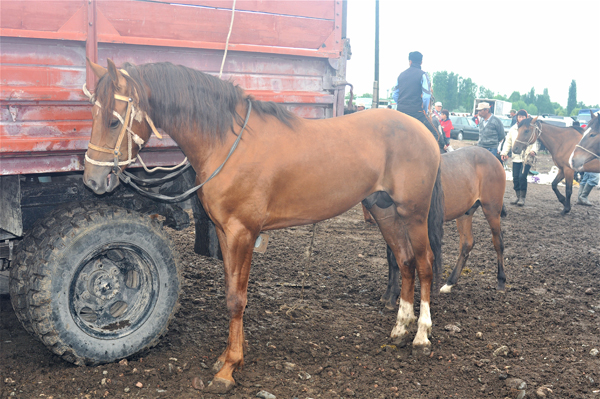
Horse reported to be a descendant of Secretariat at Tokmok market.
The Bishkek hippodrome is in the process of being refurbished to become a multi-purpose equestrian center with a covered training ring, a horse pool, a breeding farm, an obstacle course, a veterinary service and a clubhouse for members. The project developed on two hectares adjacent to the racetrack and run by Alex Youlgasheb, former consul to Bruxelles, seems to have found its calling in reconciling traditional Kyrgyz and Western equestrian sport.
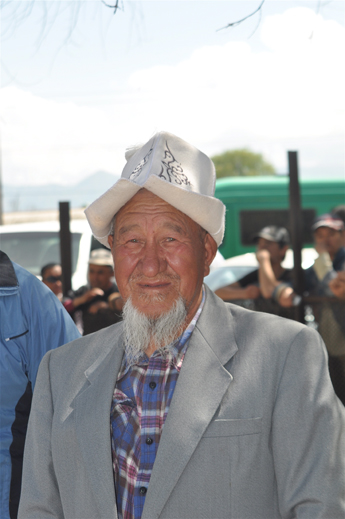
Kyrghyz spectator at Bishkek hippodrome.
On a hot May day a series of amble (jurga) and gallop flat races draws a substantial crowd to the track where the men’s white felt ak-kalpak hats mark the event as traditionally Kyrgyz. Some of the racehorses are, in Kyrgyz fashion, very young, (the Taychabysh is a 4 to 5 km race for yearlings, the Kunan Chabysh, a 9 km race for 2 year olds, the Jurgachabysh, a 6 km amble race) and ridden by young boys sometimes as young as seven or so, wearing no hard hat and riding bareback. These are short-long races from about 2 and a half to 9 km long, (in contrast with endurance races, on average 20 to 40 km long for three-year-olds).
Alex informs me, however, that the racehorses are usually not Kyrgyz but Akhal Teke crossed with Thoroughbred or Thoroughbred. In fact, one of the races ends tragically: a young horse bred at the hippodrome arrives in a state of near collapse in the last stretch. Spectators rush out to prop him up on his wobbling legs as he is given an intravenous injection. Alex mutters matter-of-factly that the horse may not survive.
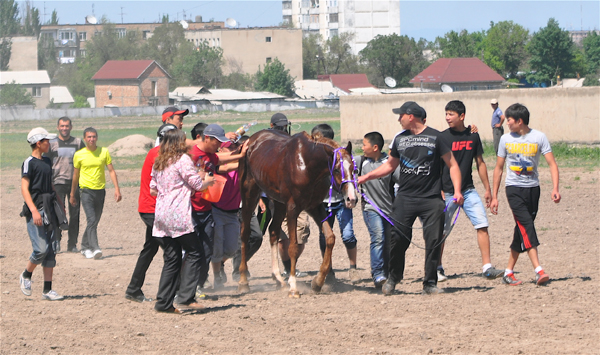
Horse at Bishkek hippodrome.
Finding the real Kyrgyz horse
The Kyrgyz horse, for his part, is reputed for his resistance and frugality, and said to have been able to travel over 66 miles daily for a week, or 100 to 166 miles in twenty-four hours. Numerous other examples are given of his exceptional hardiness.
Does such a horse correspond to the smallish, angular horses ridden by farmers on the country roads or hitched to a cart transporting potatoes around the Issyk-kul Lake some five hours east of Bishkek? And to the lean, rather straight-nosed little horses seen along the road accompanied by two or three mounted herders, or in the mountain pastures, grazing within sight of their owner’s yurt?
Admittedly disappointing in appearance, this horse seems nonetheless to have the agility of a mountain goat, often seen on steep, high altitude slopes, apparently able to live constantly outdoors, at least during the warmer seasons and despite reported wolf attacks. For indeed no stables or animal shelters of any sort are in sight.
In the valley of Sosnovka west of Bishkek, horses are larger, with a more refined conformation. Consistent with Sadyr’s information that the Russians had introduced foreign breeds into the region of Talas, a good number of them look like Thoroughbreds. Further on, in the Sousamy plain, and in conjunction with the reappearance of yurts, the horses return to a more rustic and smaller frame.
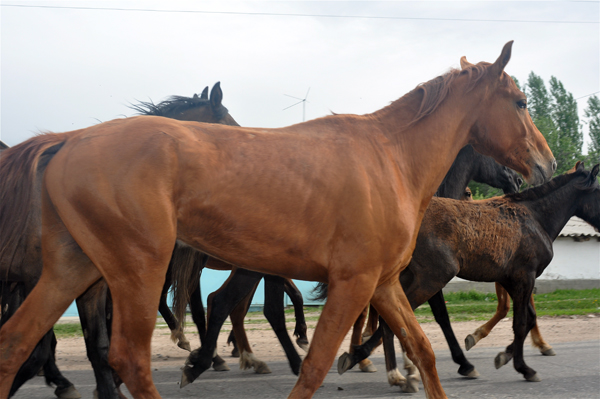
Crossbreds on the road towards Talas, a small town in northwestern Kyrgyzstan.
Eighty kilometers or so outside of Talas, the empty and degraded buildings of what was once a substantial Russian breeding establishment seem abandoned. One cremello horse of humble appearance keeps a somnolent guard in an enclosure. A passing rider informs me that the farm is still used and that the other sixty horses are grazing up in the surrounding hills. What type of horse are they? They are Novo Kyrgyz and reserved for equestrian games and races, which take place from September to October and from March to May; the national celebration of the 21st of March is a special occasion for the game of Kök Böru and Kyz Koumaiy. My informant never mentions the ‘old’ Kyrgyz type, as if it no longer existed.
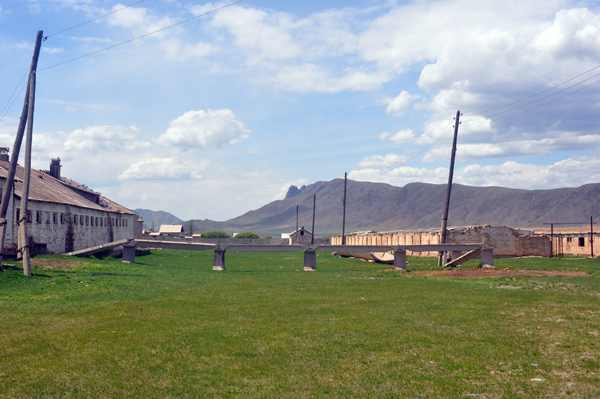
Ex-Soviet breeding farm still in use near Talas.
Back in Bishkek, a request for information on native horses at the ministry of Culture - an attractive building, on the outer walls of which the Sickle and Hammer symbol remains – rapidly leads to a meeting with the dashing minister, Mr. M R. Boromayev who puts me in touch with another Kyrgyz breeder, Satar Dykambaev.
Who is right, who is wrong?
Satar’s horse farm is a two-hectare grassland with eleven horses in some foothills on the outskirts of Bishkek. Also present are his son Sultan, an equestrian stunt man, and his nephew Ruslan who worked as an equestrian acrobat in Las Vegas, at Ringley Bros and Barnum & Bailey’s circus from 1995 to 1999. We sit outdoors sipping tea mixed with cognac surrounded by gracefully proportioned mares at about 14 hands with their foals.
Here, tells me the gravelly-voiced and extremely personable Satar, are examples of the real, purebred (asil) Kyrgyz horse. His stallion, Ushan, a liver chestnut, is brought out of the stable accompanied by a chorus of barking dogs that protect the stable against horse thieves. With his short back, broad chest, slightly dished head, the stallion has, to my eyes, a pronounced Arabian appearance. I explain my perplexity when comparing Satar’s horses to the scruffy-looking mountain animals seen north of Naryn and at Issyk-kul. ‘My horses’, he explains, ‘are Argamak Kyrgyz mountain horses for endurance racing, not to be confused with the Viouchnye or packhorse’.
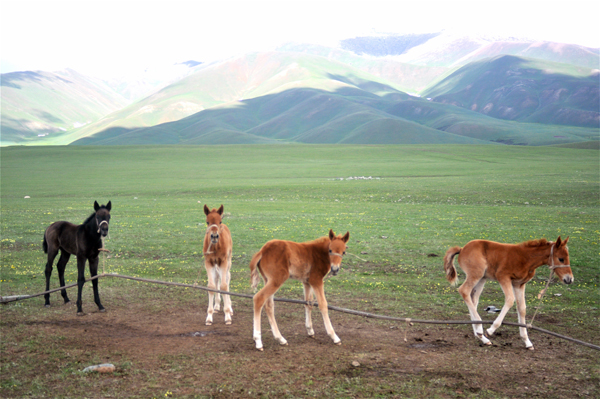
Nomad owned foals in western Kyrgyzstan.
Traditionally, the Kyrgyz horse was divided into three types: the provider of meat and milk, the saddle/hunting/war mount, and the racehorse, to which these horses correspond and which are trained from the age of one and a half throughout the year for an hour every day over eighteen kilometers.
Though Kyrgyzstan has had no studbook until very recently, hand written family records of a horse’s lineage called Sanjira, have served as certificates of origin. In the case of Satar’s horses these certificates span twenty generations.
Am I at last contemplating the authentic Kyrgyz horse?
Jacqueline Ripart, a French journalist and horsewoman, tells me that I am not. Residing in Kyrgyzstan, she has devoted herself to finding the last ‘real’ Kyrgyz horses that, according to her, are of a different height and conformation altogether. To breed them back into their native landscape she has created the Kyrgyz Aty Foundation and contributed to the creation of a stud farm at 2400 meters in the south Pamir region. Those horses that conform to standards agreed upon by the Ministry of Agriculture are recorded in a book, and a breeding register was established in 2011. To further select the best horses of this ’authentic’ type, a yearly endurance race festival (a 25 km race in rough terrain) on the southern bank of the Issyk-kul lake is organized in which horses no taller than 1.49 cm may participate.
And yet doubt remains when Satar objects that Jacqueline Ripart has wrongfully singled out the lowest quality of Kyrgyz horse, refusing to acknowledge the existence of a more refined yet nonetheless authentic type of Kyrgyz horse.
The environment defines the horse
In fact, within the whole Central Asian area and over the centuries, a large number of horse breeds or types have been identified. The deeper one investigates into regional or clanic distinctions the greater the number of horse strains or types one may find. The main distinctions, however, include the Argamak, a finer type of horse sometimes also termed ‘Oriental’; the Adayev, a name applied generally to the resistant and undemanding Kazak and Kyrgyz horses; the Karabagh (Karabair) which is similar to the Argamak or to the Akhal Teke though less refined; the Kyrgyz mountain horse, an all purpose and very resistant horse of more common appearance.
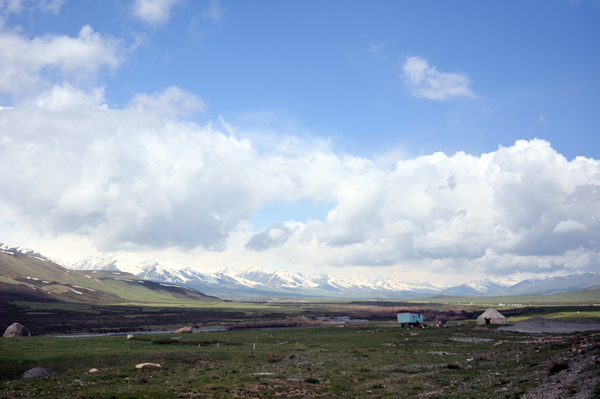
A nomad camp in Kyrgyzstan.
A discussion on the definition and survival of the authentic Kyrgyz horse today, seems doomed to inconclusiveness and futility in light of the multiple layers of cross-breeding that have occurred for generations and that continue to occur. As in the past, the seminal influences in the shaping of the Kyrgyz horse will be his natural environment and his mode of life. Since nomadic life and traditional ways have survived, the Kyrgyz horse continues to live outdoors and at high altitudes, thus ensuring the perpetuation of fundamental qualities such as endurance and sure-footedness. In turn, improved fodder and a more rigorous genetic selection will both strengthen these characteristics and refine the type. As proposed in the early twentieth century by V.A Panovsky, Russian Commissary to local horse breeding, improvement in the quality of life of horse breeders will affect positively the quality of their horses. One typical illustration of this is that foals might profit for longer periods from their mother’s milk and therefore develop better. Another is that if yearlings and two year olds are no longer ridden as they are now, they will in all likelihood grow taller and with stronger backs. Improvement in the quality of local horses may well also revitalize the Kyrgyz economy by way of sport and tourism.
Cultural symbol
The continued presence of the horse in Kyrgyzstan before and after the country’s independence in 1991, has represented something of a political and social victory over Russian and Soviet impositions. The growing horse population and enduring nomadic ways create together an ideal setting for the Kyrgyz horse to proceed towards recovery of his former self or to an avatar of that Kyrgyz archetype praised for centuries.
Article and photographs by Stephanie V. Sears
Stephanie V. Sears is a French American ethnologist and freelance journalist, essayist and poet living both in France and in the United States. Her other equine-related articles have been published in The Chronicle Of The Horse, on the Akhal Teke; in Conquistador, on Rejoneo, the Minorcan stallion and The Spanish pure-bred in harness; in Arizona Connection, on the Arabian horse in the United States; in The Canadian Arabian Horse News, on the bedouin-bred horse in Syria and the Arabian in Syria.




